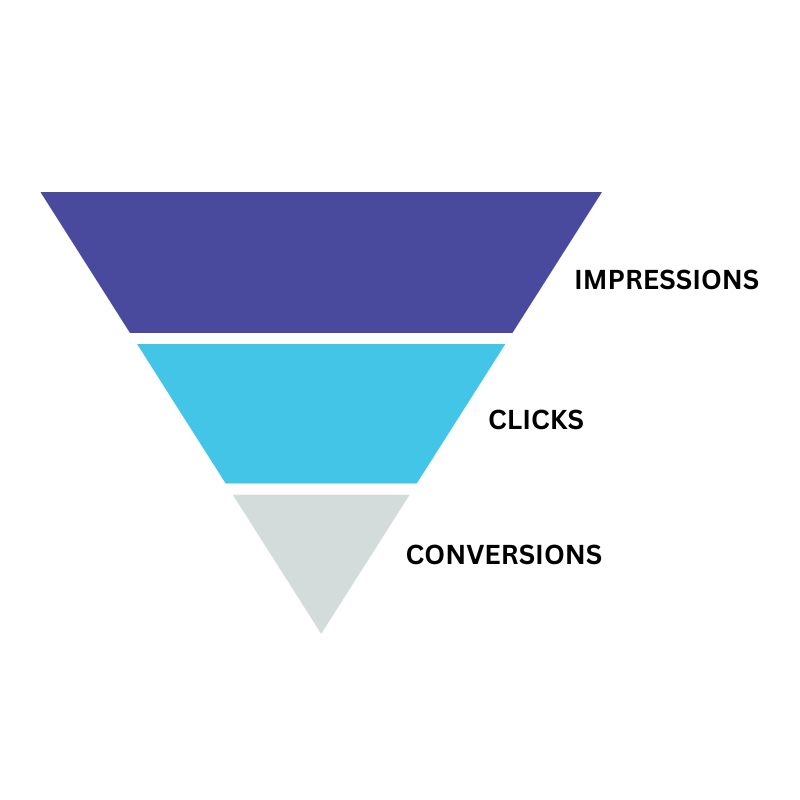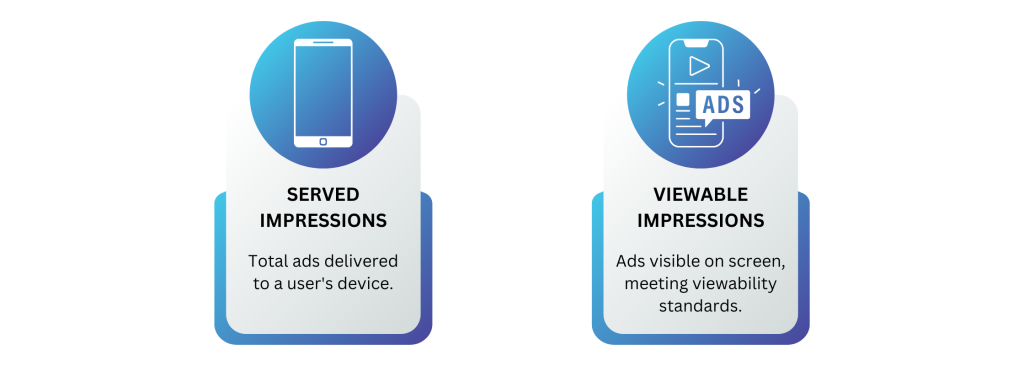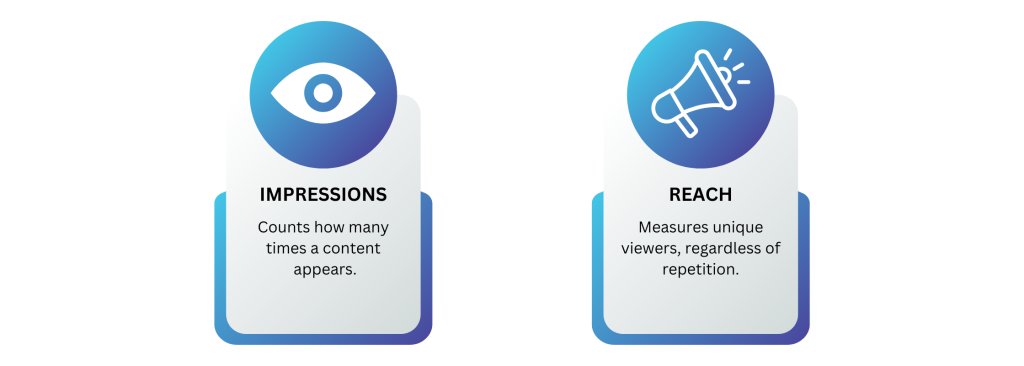What Are Online Impressions?
Digital ad impressions may look simple – just count how many times your ad appears on screen. But deeper complexity lies beneath this metric that many marketers fail to understand.
An impression count occurs when digital content renders on screen. This doesn’t guarantee anyone actually viewed it. The Interactive Advertising Bureau (IAB) now develops new standards to measure “viewable impression.” These only register when 50% of the content remains visible to a minimum of one second.
Understanding impression in digital marketing requires knowledge of several concepts. The significant differences between served and viewable impressions shape your marketing strategy. You need to grasp how different platforms track these metrics and what they mean to your campaigns.
What are online impressions and why do they matter?
Digital marketing thrives on data, and impression are its most basic building blocks. Let’s break down what they mean and why you should care about them.
Simple definition of impressions in digital marketing
Your online impression happens when digital content shows up on someone’s screen. One impression counts each time an advertisement, or webpage loads on a user’s device. Unlike other metrics, impression don’t track interaction—they just show potential visibility.
Here’s a simple way to look at it: your ad gets 1000 impressions when it appears on a website with 1000 visitors. This measurement stays consistent on all digital platforms.
Impressions tell us about exposure instead of participation. They show opportunities for viewers to see your content, whatever they do with it. Marketers learn about their message’s spread through these numbers.
How impressions stand apart from other metrics like clicks and conversions
The digital marketing funnel uses several key metrics that tell different parts of the story:

- Impressions count how many times your content appears on screens
- Clicks measure when users actively engage by clicking your content
- Conversions track when users complete desired actions (purchases, sign-ups, etc.)
Impression reveal potential visibility, clicks show active interest, and conversions represent achieved goals. A 300% increase in clicks might look great, but without profitable returns, you haven’t made real progress.
These metrics work together to tell an important story. The relationship between impressions and clicks gives you your click-through rate (CTR)—this places your performance in context beyond raw numbers.
Why impressions stay a fundamental marketing metric
Impressions remain crucial despite questions about their accuracy. They help us review campaign reach and guide budget decisions. More impressions mean your content appears more often in users’ feeds.
Brand awareness grows through impressions. Your brand becomes familiar as potential customers see your content repeatedly. This recognition creates a foundation for future engagement and conversions.
Impressions give valuable feedback to marketers who want to improve their content. High impression counts with little engagement suggest people see your content but don’t connect with it. Low impressions point to distribution issues, often from targeting problems or weak bidding strategies.
Impressions work best as part of a complete measurement strategy. Combined with reach (unique viewers) and engagement (meaningful interactions), impressions paint a fuller picture of how your campaigns perform.
How impressions are actually measured across platforms
Digital platforms track online impressions in different ways. Each platform uses its own technology and standards to measure when content shows up on screens.
Website and display ad impressions
The Interactive Advertising Bureau (IAB) and Media Rating Council (MRC) have set standards for display advertising impressions. These standards count an impression only when an ad starts to render on screen. A buyer’s ad must begin loading before the system records a valid impression.
The ad becomes “viewable” only when users can see 50% of it for at least one second. This standard helps differentiate between ads that just load somewhere versus ads that users actually see.
Video content impressions
Video content needs stricter standards than display ads. A viewable video impression requires 50% visibility for at least 2 seconds.
The platform tracks “impression click-through rate” to measure how many viewers watched videos after seeing impressions. Most channels see an impressions CTR between 2% and 10%.
How GeoSpot Media tracks impressions
At GeoSpot Media, we have developed a clever, dependable way to monitor internet impressions, so enabling advertisers to view exactly how their campaigns turn out. Each time an advertisement shows up in our tracking code, macros, these tags immediately fill in with specifics on the impression, providing us with a clear, real-time view of what is happening.
Here’s what we capture with every impression:
Device ID: Identifies the user’s device, like a smartphone or laptop.
Publisher ID: Shows us the website or app where the ad was displayed.
Country Code: Tells us the geographic location of the user viewing the ad.
This is insight not only facts. It allows advertisers to examine how their campaigns are doing on many devices, platforms, and geographical areas. They can change their strategy accordingly.
Along with tracking, we sell these impressions using a programmatic CPM model—advertisers pay per thousand views. Between $0.50 and $2.00, our charges are reasonable and provide companies—especially smaller ones—a reasonably priced means of reaching their target market without overstretching their resources. Rolled into one, it is value and accuracy.
To learn more about the specific tracking macros we support, check out our detailed documentation
Served vs. viewable impressions: Understanding the difference
The rise of digital measurement has created two distinct ways to count online impressions: served and viewable. The difference between these methods is significant to accurately evaluate campaign performance.

The traditional served impression model
Served impressions represent the longtime standard in digital advertising. These impression count when an ad server delivers an ad to a webpage, whatever the viewer actually sees. This “billboard model” of measurement counts impressions even when ads appear below the fold, in background tabs, or in areas users never scroll to. These served impressions often give an inflated view of how many people saw your content.
The rise of viewable impressions
Advertisers just need more accountability, so viewable impressions emerged to solve the visibility problem. Viewable impression measure the actual number of times your target audience sees the ad, unlike served impressions. This approach tells the difference between content that loads somewhere on a page and content users actually see.
Viewable impression tracking can spot many scenarios where ads aren’t seen, including:
- Ad-blocking software
- Incompatible screen resolutions
- Users scrolling past before loading completes
- Browser windows minimized or in background tabs
Industry standards for viewability (IAB guidelines)
The Media Rating Council (MRC) and Interactive Advertising Bureau (IAB) set specific parameters that qualify as a viewable impression. These standards state:
- Display ads: At least 50% of pixels must be visible for a minimum of one continuous second
- Large display ads (242,500+ pixels): At least 30% of pixels visible for one second
- Video ads: At least 50% visible for at least two continuous seconds
Strong user interaction with an ad (such as a legitimate click) may count as viewable even without meeting these criteria. Google’s Active View technology implements these standards and distinguishes between measurable impressions and viewable impressions in reporting.
Viewable impression reflect actual exposure to your content more accurately. Many advertisers now prefer viewable CPM (vCPM) over traditional CPM pricing. This progress brings us closer to measuring what truly matters: content that reaches human eyes.
Common impression misconceptions and measurement challenges
Marketing veterans still find impression metrics challenging because several myths make them hard to understand and measure.
Impressions vs. reach: Not the same thing

People often mix up impression and reach, but they measure different things. Impressions show how many times your content shows up on screens, whatever the number of views by the same person. Reach counts each unique viewer just once, no matter how many times they see your content.
Let’s say five people see your ad three times each. This adds up to 15 impressions but reaches only five people. This difference matters a lot when you check how well your campaign works. Getting many impressions but low reach usually means the same people keep seeing your content repeatedly. While this helps reinforce your brand, it might not help you find new audiences.
The visibility problem: Did anyone actually see it?
The biggest concern about impressions is whether people actually saw the content. Basic impression counting happens when content loads, even if users can’t see it below the screen or in hidden tabs. This measurement gap pushed the industry to create viewability rules. These rules now need 50% of display ad pixels to show up for one second.
The visibility issues continue despite these rules. Pre-loaded pages, screen size mismatches, and quick scrolling make impression counts less reliable. Plus, served impressions don’t tell us if people paid attention – they might completely miss a technically “viewable” ad.
Bot traffic and impression fraud
Non-human traffic creates much of the inflated impression numbers. Bots make up more than 40% of internet traffic, and much of it is harmful. These bots pump up impression numbers without giving any marketing value.
Fraudsters use these common tricks:
- Pixel stuffing (ads squeezed into 1×1 pixel frames)
- Ad stacking (multiple ads piled on each other)
- Bot views that look like real people
This fraud does more than mess up analytics. Juniper Research says advertisers wasted about $84 billion on fake ads in 2024. Marketing budgets get drained and teams can’t trust their measurements or improve their campaigns.
Conclusion
Online impression might look complicated at first glance, but becoming skilled at this basic metric is vital for success in digital marketing. Impression are a great way to get insights into content visibility and campaign reach, though they’re just one piece of the marketing puzzle.
The best marketers go beyond basic impression numbers. They think about viewability standards and combine impression data with other vital metrics like reach and engagement. This integrated approach helps distinguish real exposure from potential fraud or bot traffic.
Tracking challenges definitely exist, particularly with actual visibility and non-human traffic. Still, impressions remain a vital baseline metric to evaluate campaign performance and track brand awareness growth.
Note that each platform calculates impressions differently. These platform differences just need attention when you analyze campaign data and make strategic decisions.
Digital marketing works best when you balance impression metrics with deeper engagement indicators. Instead of pursuing high impression counts alone, create quality content that sparks meaningful interactions with your target audience.


Post Comment